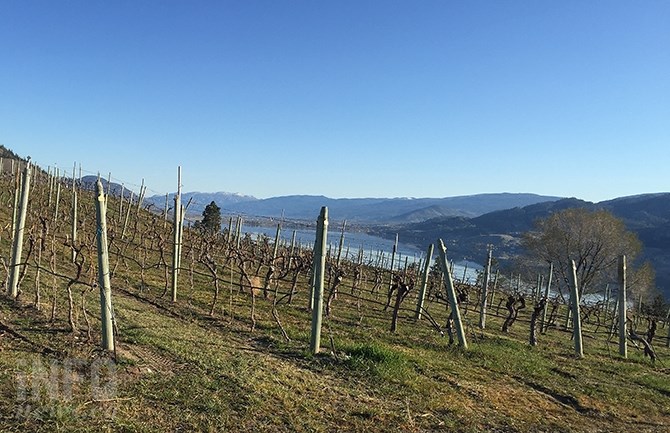Millions in replant money for Okanagan fruit growers only a small part of the solution

This week’s announcement that the province is kicking $70 million more into agricultural replant programs is welcome news, especially for the wine industry.
But it only addresses a small part of the disastrous blow climate change has dealt to cherry, soft fruit and grape grower as well as wineries.
“The money is very appreciated,” Miles Prodan, president and general manager of Wine Growers BC, told iNFOnews.ca. “More than the money is the acknowledgment of the importance of the BC wine industry and the effect of climate change on farmers across BC.”
The $70 million is in addition to $15 million already allocated in the Perennial Crop Renewal Program launched last year.
READ MORE: BC to provide $70M in support for devastated fruit and wine industry
That money is spread across the province.
At $40,000 per acre to replant grapes, a good chunk of that money could be spent just in Okanagan vineyards, but only if it's needed.
The cold spell in the winter of 2022-23 did kill some grape vines but replanting is only feasible if entire blocks of vines are replaced. Interplanting between healthy vines is not feasible so some wineries are struggling with a reduced number of vines and the hope that some of the damaged ones will still recover.
It also takes about two years to get new root stock grown and another three after they are planted to start producing a commercial crop.
This year’s cold snap was even worse and it is expected that almost the entire grape crop has been wiped out.
But how much damage was done to the actual vines is not yet known.
Nor are the details of how the new money will be allocated or over what period of time. Those details will be worked out over the coming weeks, Prodan said.
The provincial government news release announcing the program said it will support planting of “climate-resilient” varieties.
Some of the money will also be used to fund a BC wine grape task force. Over its two-year lifespan it's mandated to “develop a research and varietal road map for an economically viable B.C. wine-grape industry,” the news release says.
READ MORE: Don’t count Okanagan wine industry out just because this year’s crop is gone
There's also a dire need for help with wineries who will have no wine to make this year. Some may be able to import grapes to make non-VQA wine until the Okanagan crop comes back, but a number of other actions are also being contemplated.
Wine Growers BC met with growers and wine makers over the past few weeks and on March 14 completed its proposal to take to government.
Prodan expects to be meeting with government officials within days, after which he may be able to make those proposals public.
On the soft fruit side — such as cherries, peaches and apricots — the crop will be severely damaged this year, but for the most part the trees will survive so replanting is not their major focus.
“From the cherry side, we’ve had such bad luck with the string of climate events, our short-term need for our members is our key priority so we can partake in that replant and reinvest,” Sukhpaul Bal, president of the BC Cherry Association, told iNFOnews.ca. “Our main issue is not that our trees are not viable and we need to change out the trees, it’s that missing crop.”
Some cherry orchards are not expected to produce any fruit this year, marking the fifth consecutive year of frost and/or heat damage.
“We’re pretty sure it’s going to be a devastating year in the vast majority of our locations,” Bal said. “Maybe close to the water some farmers will be OK. In Naramata, where they’re really close to Okanagan Lake where there’s some warmth from the water, they may walk away with an average crop.”
What five years of damage to all these tree fruit crops has shown is that crop insurance programs need to be redesigned.
“Insurance has 20% deductible so 20% of your yield you’re not able to recover,” Bal said. “In a one-off or even a two-year scenario where you’re going to insurance, absorbing that is OK. That’s how the program is set up.
“But when you get into year five and that 20% is applied every year, it gets to be too much for a grower to bear. That’s what these extreme events have exposed in our business risk management programs is they were never contemplated for this many failures in a row.”
On the plus side, the insurance coverage is based on average crops over the previous 10 years, so there are some bumper crops still counted in when calculating that average.
That has a long-term downside since those good crop numbers are being dropped off each year and replaced by bad crop seasons, so going forward that average crop calculation goes down, resulting in lower insurance payouts.
READ MORE: Okanagan apple growers consider marketing commission to sell their fruit
The fruit sector that's likely least impacted by climate change are the apple growers because those are hardier trees.
That industry is facing a string of low price years that have apple growers reeling. They're now looking at creating a marketing commission to centralize their selling efforts in hopes of getting back to earning viable returns.
To contact a reporter for this story, email Rob Munro or call 250-808-0143 or email the editor. You can also submit photos, videos or news tips to the newsroom and be entered to win a monthly prize draw.
We welcome your comments and opinions on our stories but play nice. We won't censor or delete comments unless they contain off-topic statements or links, unnecessary vulgarity, false facts, spam or obviously fake profiles. If you have any concerns about what you see in comments, email the editor in the link above. SUBSCRIBE to our awesome newsletter here.


